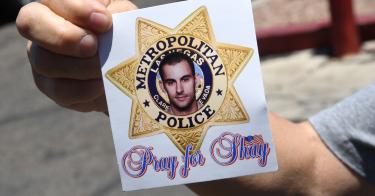Jacob Blake.
By now, that name rings with deep meaning for anyone remotely paying attention to the national news over the last few weeks. The video of his shooting by a Kenosha, Wisconsin, police officer has been widely publicized, analyzed and criticized. Blake’s paralysis and ongoing recovery have routinely made headlines, his life both lionized and scrutinized by every major media outlet.
But months before Jacob Blake was shot, another man was paralyzed—a man whose name you likely don’t know.
Officer Shay Mikalonis, a 29-year-old four-year veteran of the Las Vegas Police Department, was shot in the head on June 1 while arresting a protestor during a Black Lives Matter demonstration.
According to several accounts, the man who allegedly shot Mikalonis—Edgar Samaniego—appears to have simply walked by the officers and opened fire on them without warning or provocation.
Mikalonis underwent separate surgeries to remove a bullet from his neck and repair his shattered jaw. He is currently on a ventilator, paralyzed from the neck down and unable to speak. According to his family, Mikalonis “is awake and seems to recognize his family members,” and has since been transferred to a long-term care facility.
Like Jacob Blake, Mikalonis has a long road of recovery ahead.
Unlike Jacob Blake, no presidential candidates have come to visit him. His name hasn’t been plastered all over headlines. And it is time to ask the question, “Why?”
It is true that there are some distinct differences between the two shootings.
One shooting, of course, was caught on viral video while the other was not—though that alone does not seem to account for the disparity in coverage given how even those incidents of violence against the police caught on camera still rarely receive the same attention received that is so often given to reverse encounters.
There are those who will argue that because Mikalonis was a cop, he willingly chose to place himself in danger, unlike Blake, who is a civilian. But that’s not entirely true, either. Blake knowingly violated a no contact order, physically fought with police officers and was non-compliant with lawful demands of officers who had very valid reasons to arrest him.
Does this alone justify an officer shooting Blake seven times in the back? Not necessarily. But Jacob Blake is not Breonna Taylor sleeping innocently in her bed, either. His choices, like Mikalonis’, put him at increased risk for violent confrontations with police. Unlike Mikalonis, Blake’s choices were roundly unlawful.
Perhaps the answer is that Mikalonis’ shooter was immediately apprehended and charged with criminal offenses, while the officer who shot Blake is merely on administrative leave pending an investigation into his actions. But this alone does not suffice, either—there are really no legal justifications for a civilian to intentionally shoot a police officer, while there may in fact be legal justifications for a police officer to shoot a civilian.
Perhaps the most pervasive, and reasonable, explanation is that Jacob Blake’s shooting is inherently tied to the broader movement against perceived police brutality. His shooting is integral to a national conversation about police reform.
But to that extent, so is the shooting of Shay Mikalonis.
We cannot have a meaningful conversation about alleged police brutality or police reform without also recognizing and appreciating the very real dangers that police officers face from suspects on a daily basis. We cannot successfully prevent future violent interactions between police and civilians without also understanding the ways in which law enforcement officers know those interactions can go very wrong, very quickly.
Consider what happened in Lincoln County, North Carolina, just one day after Jacob Blake was shot in Kenosha. As in Wisconsin, deputies responded to a call about a domestic disturbance, only to discover that the subject of the call had active warrants for his arrest stemming from serious charges. As in Wisconsin, the subject of the warrants was uncooperative and combative, very clearly not wanting to go to jail that day. Unlike in Wisconsin, it was not the deputies who shot the man they were trying to arrest, but the man who shot and wounded the two deputies.
This shooting, like that of Shay Mikalonis, matters to the national conversation about policing as much as the shooting of Jacob Blake.
So what is it, then, that prompts an entire nation to recognize and celebrate the life of a man with a checkered history paralyzed by a questionable police shooting, but to roundly ignore another man’s suffering because of the uniform he wore?
Maybe there isn’t a good answer.
That doesn’t mean we should ignore the question.
This piece originally appeared in The Daily Caller




